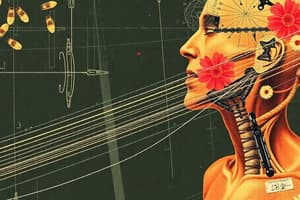Podcast
Questions and Answers
What role does ATP play in muscle contraction?
What role does ATP play in muscle contraction?
- It transfers energy necessary for muscle contraction. (correct)
- It initiates nerve impulses for muscle contraction.
- It provides structural support to muscle fibers.
- It acts as a binding agent for calcium in the sarcoplasm.
What occurs when depolarization spreads across the muscle fibers?
What occurs when depolarization spreads across the muscle fibers?
- Myosin heads become detached from actin filaments.
- Calcium is released from the sarcoplasmic reticulum. (correct)
- Actin filaments contract without calcium involvement.
- ATP is synthesized at a higher rate.
What effect do calcium ions have on the troponin-tropomyosin complex?
What effect do calcium ions have on the troponin-tropomyosin complex?
- They enhance the elasticity of the muscle fibers.
- They stabilize the complex to avoid detachment.
- They cause a conformational change that exposes active sites on actin. (correct)
- They prevent myosin from binding to actin.
What happens to the actin and myosin filaments when calcium ions and ATP are no longer available?
What happens to the actin and myosin filaments when calcium ions and ATP are no longer available?
What is the power stroke in muscle contraction?
What is the power stroke in muscle contraction?
What occurs when the thick and thin filaments slide past each other during muscle contraction?
What occurs when the thick and thin filaments slide past each other during muscle contraction?
What is the role of ATP in muscle contraction?
What is the role of ATP in muscle contraction?
Which component is found in the middle of the A band in a sarcomere?
Which component is found in the middle of the A band in a sarcomere?
What happens to the myofilaments during muscle contraction?
What happens to the myofilaments during muscle contraction?
During muscle relaxation, what happens to the actin and myosin filaments?
During muscle relaxation, what happens to the actin and myosin filaments?
Which section of the sarcomere is characterized solely by the actin filaments?
Which section of the sarcomere is characterized solely by the actin filaments?
What is primarily responsible for the banded appearance of skeletal and cardiac muscles?
What is primarily responsible for the banded appearance of skeletal and cardiac muscles?
What triggers the activation of muscle fibers for contraction?
What triggers the activation of muscle fibers for contraction?
Flashcards are hidden until you start studying
Study Notes
Muscle Contraction and the Sliding Filament Theory
- Muscle contraction occurs when muscle fibers receive sufficient ATP and are activated by a nerve impulse.
- Thick (myosin) and thin (actin) protein filaments slide past each other, shortening the myofibrils.
- Myofibrils consist of repeating sections called sarcomeres, which create a banded appearance in muscle tissue.
- Skeletal and cardiac muscles exhibit a striated appearance due to the arrangement of sarcomeres.
Sarcomere Structure
- Sarcomeres are defined by the distance between successive Z lines, which are protein discs located in the middle of the thin filaments.
- The A band corresponds to the length of the thick myosin filaments.
- The overlapping region at the ends of the A band appears dark due to the presence of both thin and thick filaments.
- The H zone is a lighter region in the center of the A band, containing only myosin filaments.
- The I band is the distance between successive thick filaments and contains only actin (thin filaments).
Mechanism of Contraction
- As actin filaments slide over myosin filaments, the Z lines are drawn closer, resulting in sarcomere shortening.
- This contraction shortens the overall muscle fiber, leading to a shortening of the whole muscle.
- Myofilaments maintain the same length during contraction; they overlap more but do not change in length.
- Muscle relaxation occurs as actin and myosin filaments slide back to their original positions.
Energy Requirements
- Energy sourced from ATP breakdown is essential for the contraction of muscle fibers.
- ATP decomposes into ADP and a phosphate group, releasing energy for muscle activity.
- ATP is regenerated through cellular respiration to maintain muscle contraction processes.
Role of Calcium and Crossbridge Cycling
- Upon depolarization, the muscle fiber surface triggers the release of calcium ions from the sarcoplasmic reticulum.
- Calcium increases the concentration at sarcomeres and binds to troponin on actin, exposing active sites.
- The energy from ATP breakdown facilitates conformational changes in myosin heads, causing a power stroke that pulls actin filaments toward the center of the sarcomere.
- Myosin heads undergo repeated cycles of binding, pivoting, and detaching, powered by ATP breakdown.
Relaxation
- Absence of calcium ions (Ca2+) and ATP leads to muscle fibers returning to their resting state.
- At any time, a combination of contracted and relaxed fibers exists within the muscle.
Studying That Suits You
Use AI to generate personalized quizzes and flashcards to suit your learning preferences.




